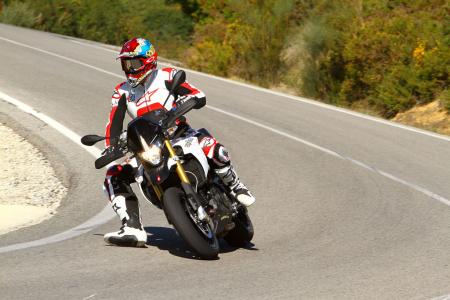 |
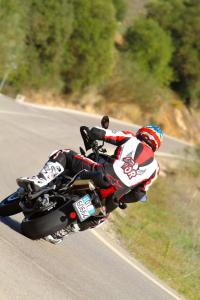
The new steel-trellis frame might look the same as on the 750, but it’s stronger and stiffer and hence a little heavier. Aprilia has compensated a little by making the rear subframe lighter, but there’s no reason to think that improvement won’t benefit the 750 in the future. The Dorsoduro 1200 tackles the corners with great agility and that supermoto feeling where you can place the front wheel exactly where you want.
The Dorsoduro 1200 is a fairly heavy machine (457 pounds claimed dry weight) compared to something like the Ducati Hypermotard but with 30 extra horsepower to compensate. The chassis is ultra stable for this type of bike. Nailing the throttle out of first and second gear corners there’s nothing but smoothness with the correct traction control and riding mode selected.
"The Dorso 1200 just feels nimble and willing to all inputs."
Riding a supermotard to the limit sliding in and out of corners requires some superhuman skills on something like the SXV. The Dorsoduro 1200, however, allows the street-riding public to approach some of those skills in a safe way. With that big 1197cc engine and stiff chassis, I couldn’t feel anything resembling that of riding a heavy bike. The Dorso 1200 just feels nimble and willing to all inputs.
The suspension from Sachs features a 43mm USD fork with a full 160mm travel. The cantilever-style Sachs shock at the back allows 155mm of travel. The long travel allows you to brake deep into corners, and should there not be enough grip, a slide is controllable. At the rear it’s the same story, and the suspension is ready for pretty much any abuse you can think of. Riding in a straight line or even cruising the suspension isn’t too hard and soaks up bumps nearly as well as a full-on supermoto.
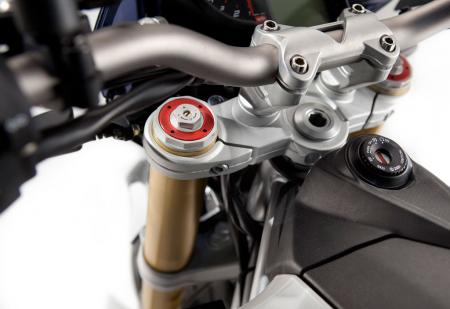 |
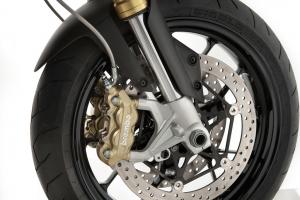
The double 320mm disc setup with radial Brembo brakes ensures plenty of power for braking maneuvers, and the 240mm rear disc with a one-piston Brembo caliper takes care of the sliding into corners nicely. In most markets the Dorsoduro 1200 will be delivered with ABS as standard. I can cope with ABS on the Shiver, but not on the Dorsoduro. The ABS works just fine as a safety feature on a rainy day, but for any other weather condition I’d prefer it off, and luckily Aprilia allows that. The ABS always turns on automatically after turning the ignition completely off and then on.
The 1197cc liquid-cooled 90-degree-vee engine has got that full and rich V-Twin feel that’s missing on the 750. The midrange is rich with torque and Twin goodness, and it accelerates in a rewarding fashion all the way from 4000 rpm and up to the max power of 130 hp at 8700 rpm. In high gears with low load there’s a fine push from 5000 revs. Maximum torque of 84.8 ft-lb at 7200 rpm ensures plenty of momentum even at much lower rpm, exemplifying of a nice and flat curve.
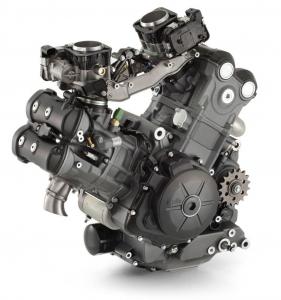
Aprilia has got two sides to it: the full on racing heart represented by the SXV/RXV and RSV4, and the bona fide road bikes represented by the Dorsoduro and Shiver. The difference is that the racing engines are 100% Aprilia-engineered while the 750/1200 engines are Piaggio (which of course also includes Aprilia) -engineered. This is good news if you’re worried about high mileage reliability on as few dealer service appointments as possible.
The new 1200c 130-hp engine isn’t stressed at all, and there’s good reason to expect a touring machine featuring this engine in the near future. The Dorsoduro 1200 accelerates up and above 125 mph easy as anything. On the motorways there’s naturally lots of wind resistance due to the upright riding position, but the seat is long (and a lot comfier than a real supermoto), and I could slide backwards and tuck my off-road helmet nearly low enough to take advantage of the small racing number-plate-style wind cowling. The mirrors provided a decent enough rearward view without too much vibration. There’s no weaving from side to side at high speed such as is typical on a 650cc single-cylinder bike.
Back on the twisty mountain roads is where the Dorsoduro 1200 really shines. In most markets the traction control will be delivered as standard with the ABS. The TC system is basically the same as on the ultra superbike RSV4 Factory APRC but with lots of features and functionality removed. The lower-spec traction control is also all you need on a bike like the Dorsoduro, and it’s adjustable on three levels plus off. I found that it gave me a lot of extra confidence just riding fast with the traction control on setting one which is the least intrusive setting. Move up to two and three and more and more torque is removed from the lower rpm calculations based on pre-programmed maps. Level three along with ABS and the Rain riding mode should allow you to pin the throttle on snow and ice, but it wouldn’t be fun.
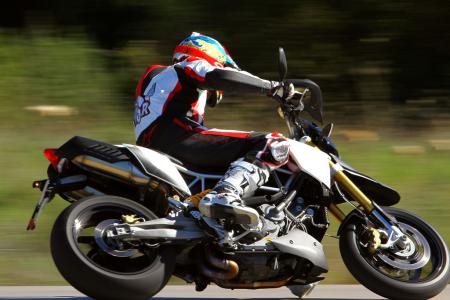 |
If you like to pull some wheelies, which by the way is a major selling point of the 130-hp Dorsoduro 1200, then the traction control needs turning off because there’s some calculations needed from the front wheel that simply disappear when the wheel is in the air. That makes the system think it should cut power, which it does. A short wheelie is still possible, but not the long second-gear ones that you really want.
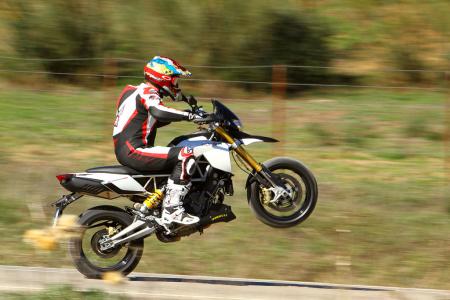 |
The Dorsoduro 1200 is all I ever wanted from the 750 that wasn’t there. The 1200 engine has got all that full richness I always look for in V-Twins. That sorted, the bike is now 100% pure fun. The Dorsoduro 1200 is better in every area than the 750, and the traction control prevents serious palpitations exiting the corners with big throttle openings on high lean. Despite the large capacity it feels much smaller than BMW’s HP2 for instance. Compared to a proper supermoto, it’s big and heavy, but surely you knew this already so it’s not a point of complaint. Due to the fact that it’s liquid-cooled and reliable, sturdily built and with useful safety features, I’m inclined to say that the Dorsoduro 1200 might be one of the city commuter’s best choices in 2011.
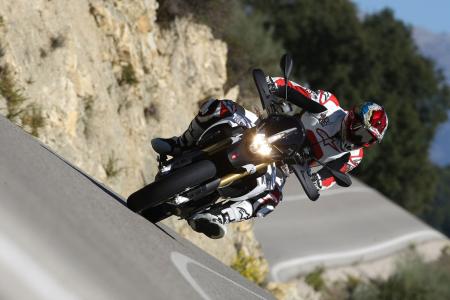 |
| Highs: | Lows: | |
|
|